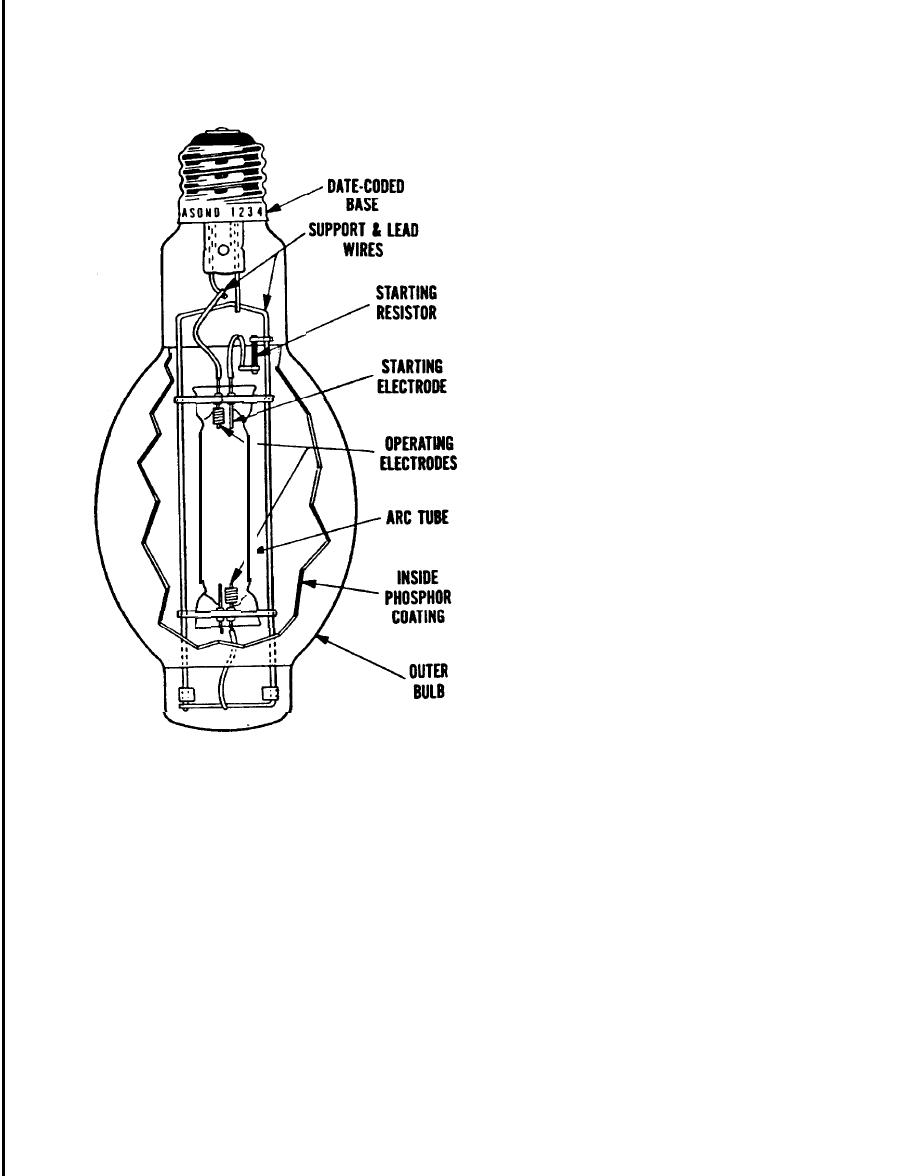

Custom Search
|
|

|
||
 TM 5-683/NAVFAC MO-116/AFJMAN 32-1083
lamp voltage as well as for changes in the line
voltage. The operating voltage of an HPS lamp can
change as much as 60 percent as it ages and the
ballast operating characteristics throughout the life
of the lamp is the key to good system performance.
High pressure sodium. is more efficient than mer-
cury or metal halide lamps.
d. Low pressure sodium (LPS) lamps. The LPS
lamps are physically and electrically similar to fluo
rescent lamps but without the phosphor coating. A
ballast is required to start the LPS lamp. There is
about a 10-minute warm-up period when the lamp
is first turned on. LPS lamps are larger than mer-
cury, metal halide and HPS lamps. The largest LPS
lamp is 180 watts, 44 inches long and emits 33,000
lumens of yellow (monochromatic) light compared to
a 400-watt HPS lamp 10 inches long which emits
50,000 lumens. There are about 1000 milligrams of
sodium in the 180-watt LPS lamp compared to 6
milligrams of sodium in the 400-watt HPS lamp.
Because of this, LPS lamps require special disposal
precautions that do not apply to HPS lamps. Appli-
cations for LPS lamps are limited to roadways or
floodlighting where color rendition is not important.
(1) Installation. A suitable ballast must be used.
The ballast must be in compliance with Illuminating
Engineer Society (IES) and/or ANSI specifications- If
using power factor correction in a star connected
multi-phase distribution, the power factor correcting
capacitor should be connected between the line and
neutral. A filter coil must be used if there is audio-
frequency switching signals on the mains. The lamp
should be installed within the indicated limits to
avoid accumulation of sodium in the arc tube. Accu-
mulation of sodium could reduce lamp life. Lamps of
90 watts or more must be set within 20 degrees of
Figure 9-2. Mercury lamp.
horizontal. Lamps of 55 watts or less may operate up
to 20 degrees above horizontal.
b. Metal halide lamps. Metal halide lamps re-
(2) Maintenance. Do not allow the lamp to be
semble mercury lamps in appearance and are used
scratched. Ensure that power is off before installing
similarly. The color produced is better than mercury
or removing the bulb. To avoid electric shock do not
lamps and control of the light is easier. The initial
touch any metal parts of a broken bulb. A great
efficiency is also better for wattages above 150W.
degree of heat is produced by contact of the sodium
Otherwise mercury lighting is more efficient. Disad-
with a small amount of water. Therefore the lamps
vantages of metal halide lamps are a higher cost,
must be stored or carried in their original container.
and a shorter life expectancy than mercury lamps.
(3) Disposal. Let the lamp cool before removal.
c. High pressure sodium (HPS) lamps. The HPS
To avoid the danger of fire or broken glass, care
lamp package is similar to the mercury vapor lamp.
must be taken in handling discarded lamps. No
Like most discharge lamps, the operating voltage is
more than 20 lamps at one time should be broken
not compatible with supply voltage and a current
into small pieces in a dry container of adequate size
limiting ballast must be used. The HPS ballast
and in an open area. To avoid injury from flying
must compensate for both variations in line voltage
glass, goggles should be worn. The broken pieces
and lamp voltage change due to ageing process in
should be sprayed with water from a distance.
the tube. The mercury lamp operating voltage
When the chemical reaction has ceased the sodium
is harmless and the broken glass should be disposed
changes very little with life. With the HPS lamp,
of as normal waste.
the ballast must compensate for changes in the
9-3
|
 |
|
 |
||